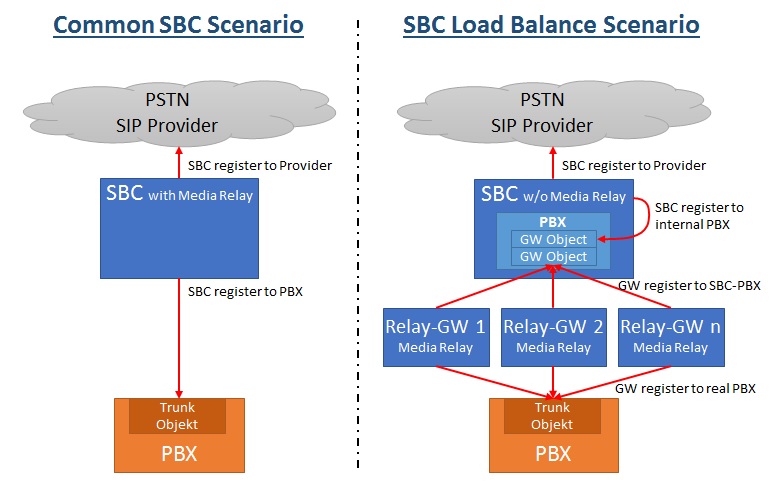Howto:SBC scaling for large number of channels: Difference between revisions
No edit summary |
No edit summary |
||
| Line 24: | Line 24: | ||
To bypass this limit, the idea is: | To bypass this limit, the idea is: | ||
* to have a dedicated Gateway without Media-Relay. This acts only as Registration Gateway to the SIP Provider. Without Media Relay this Gateway can handle a very large number of calls. We call it '''"Register-GW"''' in this document. | |||
* to have a dedicated Gateway without Media-Relay. This acts only as Registration Gateway to the SIP Provider. Without Media Relay this Gateway can handle a very large number of calls. | * to use as many Gateways as needed for Media Relay. All calls should be evenly distributed on this Gateway to have a "Load Balance Scenario". We call them '''"Relay-GWs"''' in this document. | ||
We call it '''"Register-GW"''' in this document. | |||
* to use as many Gateways as needed for Media Relay. All calls should be evenly distributed on this Gateway to have a "Load Balance Scenario". | |||
We call them '''"Relay-GWs"''' in this document. | |||
Revision as of 16:01, 1 September 2016
Applies To
This information applies to
- SBC functionality on Gateways or IPVA with v12r1 or later
More Information
Preamble
With the innovaphone SBC, we provide approximately 100 - 200 concurrent Channels per Gateway or IPVA. In bigger Scenarios where a few hundred (or more) Channels are required, several Gateways can be joined to a "Load Balancing Scenario" to provide a large number of Channels.
Also, in most scenarios an additional and dedicated SBC as SIP -Gateway to the Provider is needed (with or w/o registrations), because the most part of SIP Providers accept only one counterpart.
This document describes the principles how to configure such a "Load Balancing Scenario" with reference to an example.
Be aware that this is just an example to explain how it works; maybe it’s a little bit different in your scenarios depending on the SIP Provider!
Function Principle
The Limitation of the concurrent Channels per Gateway is based on the Media Relay Feature. If this Feature is enabled (and it’s mandatory for the SBC), the Channels are limited.
To bypass this limit, the idea is:
- to have a dedicated Gateway without Media-Relay. This acts only as Registration Gateway to the SIP Provider. Without Media Relay this Gateway can handle a very large number of calls. We call it "Register-GW" in this document.
- to use as many Gateways as needed for Media Relay. All calls should be evenly distributed on this Gateway to have a "Load Balance Scenario". We call them "Relay-GWs" in this document.
Register-GW
- On the "Register-GW" we need a PBX because only with the PBX we have an evenly distribution to several Gateways. Therefore the PBX must be enabled (Master) on this Gateway, but we need only two Gateway Objects in it. The first is for the registration from the Provider- SIP-Interface (on the same GW) and the second is for all registrations from the "Relay-GWs". No other object is needed.
- The SIP-Interface to the Provider is similar to the SBC of the "Common Scenario". It has two registrations, one to the SIP Provider and another to the internal PBX. Only Media relay is disabled.
- The default Routes between SIP Provider and PBX must be adapted.
Relay-GWs
The "Relay-GWs" are serving the Media Relay Part in this scenario. On each "Relay-GW" there are two registrations and simple routes between it.
- One registration to the "Register-GW"- PBX with Media Relay and the same SDP settings like the SIP Interface to the Provider.
- One registration to the real PBX w/o Media Relay with default settings.
